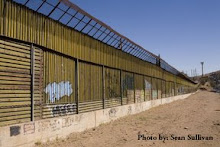Participants hope to show the nation just what is at risk if a wall is built through the city of Brownsville and along the rest of the border. Bishop Raymundo J. Peña of the Diocese of Brownsville will be the keynote speaker. The Bishop, whose diocese operates 107 parishes and missions for the almost 800,000 Catholics who live in the Rio Grande Valley, has been outspoken against the construction of a wall along the U.S.-Mexico border. The Bishop’s opposition echoes the sentiment of the Vatican, where a top official has called the U.S. plan to build a border wall “inhuman.” Community leaders, including state representatives Eddie Lucio III and Juan Escobar, will voice the concerns of their constituents, and local experts will discuss the negative impact a wall could have on our communities, historical landmarks, farms, and natural areas. While the children fly specially-made kites and smash a wall-shaped piñata, adults can listen and dance to live South Texas music into the evening.

Building a border wall along the Rio Grande will cut a wide swath through the city of Brownsville. Maps to date have shown the proposed wall following the flood control levee that runs through the city, rather than the river itself. Parts of the downtown area, with its rich history and charming old buildings, are at risk for demolition because they lie so close to this levee. The University of Texas at Brownsville’s International Technology, Education and Commerce Campus could be cut off entirely by the wall, since it lies to the south of the levee. A border wall could also threaten the close economic and social ties between Brownsville and its sister city Matamoros. Outside the city, landowners and farmers could lose land and critical access to river water for irrigation. A double-layered wall and Border Patrol road could also cut through nearby natural areas such as the Sabal Palm Audubon Sanctuary and the Nature Conservancy’s Lennox Foundation Southmost Preserve. University of Texas at Brownsville Vice President of External Affairs Dr. Tony Zavaleta said, “In my forty odd years of studying the U.S.-Mexico border I have never seen anything suggested by either government that is so wrong headed and destructive to our communities and our people as this border wall.”
To get to Dean Porter Park, exit 6th Street from Expressway 77/83. Turn right on 6th and take another right at the first light, Ringgold Street. Turn right again onto Dean Porter Park Street. The park entrance will be on the left.




_Crane_Panels(2)_03_2007_Jessica_Piekielek.jpg)
 How did we get to this situation? For one thing, Congress's inability to enact a comprehensive immigration bill has resulted in criticism of Senators and Representatives by constituents. To keep the home folk happy numerous bills have been introduced and enacted for the construction of real and virtual border walls. Last December the House passed a measure under which this wall is being built: "the Secure Fence Act, [which], mandates the construction of approximately 700 miles of pedestrian fence along the southwestern border. Within the next 2 years, 225 miles of these 700 miles are scheduled to be completed. The first 75 miles of these 225 miles would occur in areas that have already been developed (e.g., currently contains permanent vehicle barrier [PVB] or TVB) and thus, little or no additional environmental impacts would be expected." [Quote from the EA] Thus, their basic premise is that there is essentially no difference between a barrier that you can step over and a 15 foot high wall with six inch gaps.
How did we get to this situation? For one thing, Congress's inability to enact a comprehensive immigration bill has resulted in criticism of Senators and Representatives by constituents. To keep the home folk happy numerous bills have been introduced and enacted for the construction of real and virtual border walls. Last December the House passed a measure under which this wall is being built: "the Secure Fence Act, [which], mandates the construction of approximately 700 miles of pedestrian fence along the southwestern border. Within the next 2 years, 225 miles of these 700 miles are scheduled to be completed. The first 75 miles of these 225 miles would occur in areas that have already been developed (e.g., currently contains permanent vehicle barrier [PVB] or TVB) and thus, little or no additional environmental impacts would be expected." [Quote from the EA] Thus, their basic premise is that there is essentially no difference between a barrier that you can step over and a 15 foot high wall with six inch gaps._03_2007_Sean_Sullivan.jpg)

